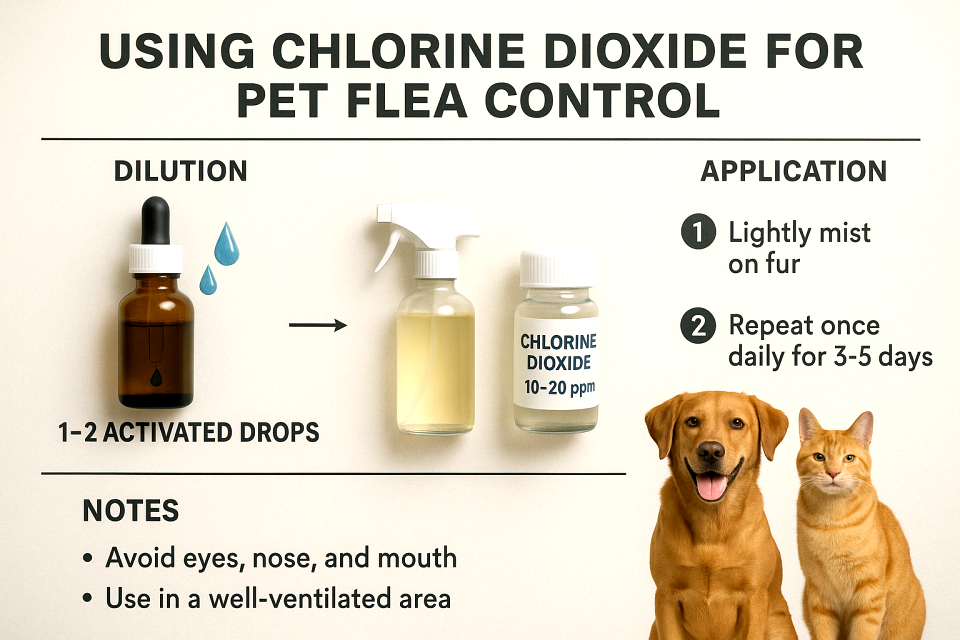1. Is Chlorine Dioxide Effective Against Fleas and Their Eggs?
Yes — chlorine dioxide (ClO₂) has been shown to be effective against a broad range of small parasites, insects, and pathogens through oxidation, not poisoning. It destroys microorganisms and small parasites by oxidizing their outer membranes and proteins, effectively killing them or rendering them unable to reproduce.
Fleas and their eggs are particularly resilient because:
- Eggs are often hidden in carpet fibers, bedding, or fur.
- Larvae and pupae stages are resistant to many topical chemicals.
Chlorine dioxide can kill adult fleas and larvae on contact, but its ability to penetrate eggs depends on concentration and exposure time.
In practice, it has been reported to reduce infestations dramatically when used correctly.
2. Using Chlorine Dioxide for Pets (Cats and Dogs)
It’s very important to use proper dilution and application methods.
Veterinarians or natural practitioners familiar with chlorine dioxide recommend using very mild concentrations.
Topical Use
For cats or dogs:
- Mix: 1–2 activated drops of chlorine dioxide (MMS or CDS equivalent ~10–20 ppm) in 1 cup (250 ml) of distilled water.
- Application: Lightly mist on fur or wipe the coat with a damp cloth.
- Avoid the eyes, nose, and mouth.
- Focus around the neck, tail base, and belly (favorite flea areas).
- Frequency: Once daily for 3–5 days, then once weekly for prevention.
Many pet owners report that fleas fall off or die within minutes. The oxidation is brief, and because chlorine dioxide breaks down into salt and oxygen, there’s no lasting residue.
Oral (Internal) Support
For detox or immune balance:
- Add a trace amount (one drop of activated chlorine dioxide in 1 quart of water) to drinking water.
- Allow pets to drink freely.
This helps cleanse the bloodstream and may repel parasites naturally.
Note: Cats are more sensitive than dogs. Always start very low (half-drop equivalent per quart). Never give concentrated solutions orally.
3. Using Chlorine Dioxide for Humans Against Fleas
Humans can safely use low-dose topical chlorine dioxide solutions for external pests.
Topical Skin Application
- Mix 1 activated drop per 4 oz (120 ml) of distilled water.
- Use a spray bottle or a damp cloth to wipe legs, arms, and ankles (areas fleas bite).
- Let air dry — the faint chlorine smell will dissipate quickly.
Some people also report benefits by:
- Adding 2–4 activated drops into a bath of warm water (about 10 gallons) for a 10–15 minute soak, to calm itching and kill any residual fleas or eggs on the skin.
This also helps with bacterial skin irritation caused by flea bites.
4. Using Chlorine Dioxide Around the Home
This is where chlorine dioxide really shines. It can be used to disinfect surfaces, carpets, and bedding, killing fleas, larvae, bacteria, and odors all at once.
Household Spray
- Mix 10 activated drops per quart (liter) of distilled water (around 100 ppm).
- Spray lightly on:
- Carpets
- Pet bedding
- Upholstery
- Under furniture
- Let it dry naturally (ClO₂ breaks down into salt and oxygen).
Mop or Wash Additive
- Add 10–15 drops of activated to a gallon of mop water.
- Wash floors or fabrics where pets rest.
Repeat every few days until no fleas are observed.
Chlorine dioxide also helps neutralize odors and molds, a bonus benefit.
5. What About Ticks?
Ticks are tougher than fleas, with thicker shells and stronger attachment mechanisms.
Chlorine dioxide can kill ticks on contact, but works best before attachment or shortly after removal.
For Ticks:
- Apply a few drops of 10–20 ppm solution directly on the tick.
- Wait 30–60 seconds — the tick will weaken and can be removed easily.
- Clean the bite area with 1–2 activated drops in a tablespoon of water to disinfect.
Many people who live in tick-heavy areas also spray their socks, shoes, and pant legs with a light mist of chlorine dioxide before going outdoors.
6. How It Works (Simplified Chemistry)
Chlorine dioxide doesn’t poison pests — it oxidizes them:
- It steals electrons from cell membranes, proteins, or parasites’ outer coatings.
- This reaction neutralizes bacteria, viruses, and small parasites instantly, without leaving toxic residue.
- It reverts to salt (NaCl) and oxygen (O₂) — safe end products.
This makes it one of the cleanest pest control agents when used correctly.
Precautions
- Always dilute properly. Concentrated chlorine dioxide can irritate skin, eyes, or lungs.
- Do not spray near eyes, nose, or mouth (pets or humans).
- Use in well-ventilated areas.
- Store away from sunlight and heat.
- Test a small skin patch before broader use.
Summary
| Application | Concentration | Method | Notes |
| Pet coat (cats/dogs) | 10–20 ppm | Light mist or wipe | Avoid eyes/mouth |
| Drinking water (pets) | <1 ppm | 1 drop/quart | Start very low |
| Human topical | 10–20 ppm | Spray or bath | Soothes bites |
| Household use | 50–100 ppm | Spray/mop | Kills fleas/larvae |
| Tick removal | 10–20 ppm | Apply on tick | Wait 1 min, remove |
